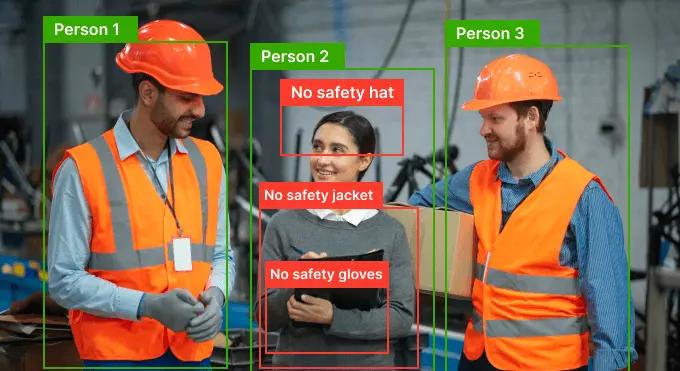Effective Workplace Safety and Compliance Monitoring with Computer Vision AI

Nowadays, as more people are getting involved in business safety infrastructure practices, it has become relevant to enhance employee awareness of workplace risks. Therefore, it results in increased safety processes. Workplace safety is significant for both employers and employees. A safe working environment is capable of fostering a productive and positive atmosphere resulting in improved employee morale, reduced absentees, and lower turnover rates. Workplace safety helps protect businesses from financial losses relating to accidents. In this blog post, we are going to shed a major light on how computer vision AI has improved workplace safety & compliance monitoring in workplaces.
How Computer vision Technology Enhances safety measures
By means of running AI models on camera, computer vision can easily identify potential risks. It can track movement in video feeds and analyze data. Additionally, it can establish patterns and recognize areas where improvements can be made. Prior prediction of hazards enables proactive measures to be taken to prevent injuries.
Prevent workplace accidents with AI & Computer Vision
Facial recognition & employee tracking
When facial recognition technology is integrated with computer vision, it can monitor employee movements throughout the workplace. It supports access control measures and tracks authorized individuals entering the workplace. Right from employee attendance management to detection of unauthorized access in restricted areas, AI analytics & computer vision provide timely alerts to mitigate dangers.
Object detection & recognition
Computer vision powered by AI can automatically track and recognize objects within the workplace. It enables seamless identification of potential hazards. The technology ensures personnel safety by administering real-time alerts and reducing the risk of accidents. These accidents are generally caused by unattended tools and malfunctions.
Accident & fall detection
Computer vision is empowered with the potential to detect if an employee has fallen or been involved in an accident. Immediate notifications are sent to the relevant parties enabling prompt responses and timely medical assistance when essential.
Hazardous material identification
Different industry verticals need the handling of hazardous materials. Computer vision can assist in ensuring proper compliance with safety regulations. AI-enabled vision systems can automatically recognize dangerous substances and keep close monitoring of the uses, storage, and disposal of hazardous material.
Data-driven safety insights & continuous improvement
Artificial intelligence combined with computer vision can administer valuable data-driven insights into workspace safety, patterns, and trends of incidents. The data can be utilized to continuously improve safety programs, allocate safety resources, and recognize areas of improvement.
Safety gear detection
Several industries require advanced safety protocols like automatic detection of safety gear to avoid accidents across sites. AI and computer vision can automatically monitor worker compliance with safety regulations and personal protective equipment. This can assist in ensuring that workers are wearing safety gear while they are set to work on a specific task.
Various industries are harnessing AI-based safety monitoring software to improve overall employee safety and exploring real-world examples of effectiveness.
Effective implementation of computer vision for workplace safety across industries
Time to delve deeper into the different industry verticals that have powerfully implemented computer vision and AI into real-world examples.
Construction sites
Construction sites have different risks such as falls, exposure to harmful materials, and equipment-related accidents. AI-enabled safety monitoring systems help mitigate the risks by monitoring construction site activities, recognizing potential hazards, and tracking worker movements. Computer vision can easily recognize unauthorized personnel and intruders faster improving overall site safety and contributing to a safer workplace.
Manufacturing
Computer vision can seamlessly improve safety within manufacturing environments. With effective monitoring of the workspace, AI vision can detect anomalies, identify potential threats, and send alerts to prevent accidents. It streamlines equipment maintenance and enhances overall operational efficiency. Fire and smoke detection are also useful features of computer vision powered by AI. Timely detection can prevent any catastrophic incident from occurring.
Retail operations
The retail market scenario is different from other industries. Leveraging video data and generating actionable insights plays an important role. Computer vision powered by AI helps in analyzing customer interactions, identifying potential loss risks, and detecting unusual activities. Therefore, it was relevant to analyze video data in real time and prevent workplace incidents like vandalism and theft. Understanding customer behavior and interactions can lead to improved service and shopping experiences.
Final Thoughts
Computer vision powered by AI can easily detect employee safety hazards and prevent workplace accidents with predictive analysis. By comprehending the technology and implementing it, businesses are capable of safeguarding their employees from potential hazards and avoiding dangers. Nextbrain’s AI-enabled workplace safety management system serves as a potential tool enhancing capabilities and allowing them to foster a productive work environment. Connect with our professionals to learn more about Computer vision AI.